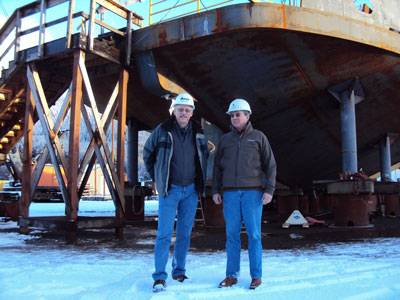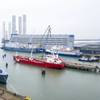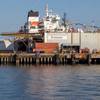A Success Story: Alaska Ship & Drydock
By Raina Clark in the January edition of MarineNews
A new maintenance company with no shipyard experience takes a struggling repair yard, converted from an old cannery, and transforms it into a success story. Alaska Ship & Drydock (ASD) is on its way to achieving its vision of becoming the maritime support center for the North Pacific and Arctic Oceans. The yard’s story is tied to the economic development in Southeast Alaska and its turning point came with the construction of the MV Susitna, the first ice strengthened twin hull ferry, commissioned by the Office of Naval Research.
Alaska Ship & Drydock (ASD) started out as Ketchikan’s Sunny Point Cannery. “The first planning documents that the state of Alaska did for the yard was in 1976,” said Doug Ward, Director of Shipyard Development at ASD. “At that time, the yard was intended to be the Alaska Marine Highway System Winter Maintenance Facility.”
The Marine Highway System (MHS) built out its fleet in the 1960s. However, Ward said, “the small commercial yards that were [in Alaska] at the time didn’t have the capacity to maintain the modern, steel vessels that were coming on line.”
“The authors of the studies recognized that a lot of money and jobs in support of the MHS were being exported out of Alaska because the capacity to repair the fleet did not exist in the State.”
“There were two main motivations, on behalf of the state, to develop the yard,” Ward said. “One was to reduce the cost of operating Marine Highway System vessels in Alaska. The other was to provide economic strength and diversity to the Alaska economy.”
By 1980 the state legislature began appropriating money, a little over one million in 1980s dollars, to purchase the Sunny Point Cannery site. “They looked at a number of communities, from Kodiak to Ketchikan,” Ward said. The state purchased the defunct cannery because “Ketchikan is a central location to the ferry routes and has frequent passenger and barge service to Seattle. Ketchikan has also historically been the transportation and industrial hub of Southeast Alaska.”
Alaska’s Department of Transportation and Public Facilities (DOTPF), the state agency that took control of the facility, studied the potential yard and came out with an engineering plan in 1981. The planners recognized that the annual maintenance budget for MHS wasn’t large enough to support a full service shipyard. So the state planners began looking at other vessels with an eye toward building the yard with enough capacity to serve non-MHS vessels as well. These other vessels included NOAA, Coast Guard and state research vessels, as well as fishing vessels and workboats.
The state-owned Alaska Ship & Drydock opened in 1987, operated by a private contractor, but had difficulty finding enough work to stay open. As a result of the marine response to the Exxon Valdez spill, the yard received an influx of contracts, improving its situation for a time. However, after just a few short years in operation, the yard closed.
New Blood for an Old Business
In 1992 the State came out with an RFP for a new private contractor to re-open and operate the yard. The RFP required an operator with a minimum of 10 years shipyard management experience. “That eliminated any Alaskan contractors,” Ward said. The first round of proposals failed to find any qualified candidates.
At the time, Ward worked for the construction and industrial maintenance company then called Ty-Matt. “We had been watching the yard and noticed that the peak demand for ship repair services is in winter, which is counter-cyclical to most economic activity in the state, particular in the Southeast.”
“We were a general contractor doing maintenance work out at the Ketchikan pulp mill. That was our primary customer. But that work was seasonal. We worked through the summer and had to lay people off in the winter. So we saw the shipyard as having the potential to provide year round employment for our construction crew. Year round employment in this state is golden.”
After he saw that the first round of proposals for the Ketchikan shipyard had been unsuccessful, Randy Johnson, President of Ty-Matt, wrote to then Governor Wally Hickel. “Randy asked him to remove that experience requirement and let Alaska contractors have another shot at operating the yard,” Ward said. The Governor agreed. Johnson’s company applied and was awarded a three-year contract to operate ASD in November 1993. The objectives were to reactivate and complete maintenance on the shipyard, complete maintenance on two MHS vessels and seek funding for shipyard expansion.
“The intent was to get enough infrastructure in the yard so that it could operate year round and provide full-time employment,” Ward said. “Being a new shipyard with new people and inadequate capacity, it was a real challenge to get new customers to come in. There was some deserved skepticism from the state. We were a new maintenance company.” While the company proved itself as a shipyard operator, Ward said, “It was a long three years.”
The Big Objective: Economic Development
When it came time to meet the objective to expand the capacity and market share of the yard, Johnson sought a more fitting home for ASD in state government. Alaska’s DOTPF, which originally controlled the yard when it was purchased, is an agency designed to provide safe and efficient transportation for movement of freight and people, but it does not have an economic development mission. Ward said the early planning documents for the yard recommended that after the conclusion of construction, ownership be moved transferred to an authority like the Alaska Industrial Development Authority (AIDA). But at the time the yard went operational, AIDA didn’t have any projects on such a scale and it didn’t own real estate.
In the late 90s, near the end of his firm’s first three years as yard operator, Johnson had a chance meeting with then Governor Tony Knowles on an airplane during a business trip. On that plane, Johnson asked Knowles if he would support transfer of ownership of the yard to AIDA. Johnson’s proposition was accepted and in 1996 the facilities ownership was transferred from DOTPF to AIDA. It was one of the first pieces of real estate that AIDA controlled.
“One of our motivations for getting the yard over to AIDA was that they understood the nature of economic development projects, for one, and they also had access to finance tools.” Around that time closure of pulp mills in the state caused enormous job loss and economic disaster relief money came into the area. Through AIDA, some of that money was invested in ASD to grow its potential as an employer in the area. Specifically, the 1999 Ketchikan Shipyard Development Plan, or “99 Plan,” as Ward refers to it, was created with these funds.
The 99 Plan: Yard Expansion
“At that point the Matanuska-Susitna [Mat-Su] Borough commissioned Northern Economics and Kvaerner Masa Marine Inc. to conduct a development plan study for the project,” said Ward. “Kvaerner Masa at that time was one of the leading northern European shipyards. They brought over their lead shipyard designer … and provided a footprint and introduction to northern European shipbuilding and repair.”
ASD also called on the expertise of Dr. Larry Gebherdt, who introduced the yard to the notion of concurrent development. “As we went into the 1999 Development Plan, we realized that there have been many publically funded projects that have failed because of the mentality of build-it-and-they-will-come.”
“The principles of concurrent development say it’s not enough just to build infrastructure. In order to mitigate risk to the enterprise, it’s important to also have an eye on the market to create demand as well as looking at the workforce so you can manufacture competitively. … Part of concurrent development is to look at the various classes of risk that exist and assign the various risks to the partners that are best able to manage that risk.”
“So that’s the approach we’ve taken,” Ward said. “AIDA has been a great partner in that. They’ve stepped up to the plate. They own the real estate and are managing the public investment in the facility while we focus on the operations of the facility and developing the market.”
Research for the 99 Plan found that in ASD’s region “there were roughly 1,500 ships, 95% of which were 250-ft and 2,500 long tons or less. So our infrastructure footprint is built around that class of vessel.” The plan also calls for large enclosed repair facilities capable of bringing 250-ft ships onto land. “That helps mitigate the risk to schedule and cost and increases quality, on the repair side of the market, by going indoors,” Ward said.
“Right now we’re breaking ground on the very large ship hall, a land-level enclosed berth. We will be putting out contracts for construction of the ship hall and construction will begin 2011. We would like it to be ready for service in spring 2012.”
“In the 99 Plan we also introduced the ability of the yard to do new ship construction. Repair alone goes through cycles, can be fiercely competitive and has seasonal peaks to it. New construction is a year round activity and provides a base level of employment.” The yard’s first new build was in 2000, a small ferry that runs between Ketchikan and the airport.
The Turning Point: MV Susitna Comes to Ketchikan
All the studies and planning that went into Alaska Ship & Drydock paid off with the arrival of the MV Susitna contract. Around 2004, Ward said, “the Office of Naval Research [ONR] came along with the MV Susitna, or Expeditionary Craft [E-Craft].”
Admiral Jay Cohen was commanding the ONR at the time. “Part of the motivations of Adm. Cohen was to avoid the cost of large shipyards and defense contractors. He was looking for a company and a yard that was ready for innovation and capable of building a complex vessel.”
“Adm. Cohen knew it was going to be a new kind of ship, and rather than build a one-off prototype that would have no commercial purpose, he wanted to have the naval technology be transferred to the commercial side so there would be practical application of the technology during the demonstration period and eventually be able to be commercialized in the region it was built.”
“So that set the stage,” Ward said. “Adm. Cohen found out that we were interested in the project and came out to look us in the eyes and see if we were serious about it, see if we were capable of doing it. And he wanted to look at the region and see if the technology was going to be transferable. He found ‘yes’ was the answer to all those questions and eventually we ended up getting the contract to build it here in Ketchikan.”
According to Ward, the E-Craft is part of a Navy initiative called Forward Sea Basing. “The Navy wanted these forward sea bases that would be mobile and could loiter out of harm’s way in the ocean, a hundred nautical miles or more offshore. Those would be the forward supply bases and then they would need a connector vessel. That vessel is the E-Craft, which drives from those forward sea bases, through the surf and onto the beach.”
“Those were some pretty unique requirements,” Ward said. Previous landing craft designs weren’t meant to travel as far or move as fast as the E-Craft design. With its variable draft design, the E-Craft is capable of maintaining a deep draft through heavy sea states, and then transforming into a beachable shallow-draft vessel.
“It’s an extreme example of a mix of products that we described in our 99 Plan that would be part of our new build market. What we called these vessels then was ‘rapidly deployable affordable ports and harbor structures.’”
“The vessel itself is going to be owned and operated by Mat/Su Borough as a commercial ferry between Anchorage and Port McKenzie. Now the Navy doesn’t have to support the sea trials, it’s getting an extended demonstration period and the Mat/Su Borough will collect the operational information — there are strain gauges throughout the ship. The Navy will have a prolonged operational period to get information about the design and how well it works.”
“The commercialization of E-Craft technology represents our new construction market,” said Ward. “It’s a purpose built ship for Alaska — the world’s first ice strengthened twin hull vessel. It is efficient over long distances, can operate in many sea states, and most importantly, doesn’t require expensive terminal and marine civil infrastructure. It can land on a beach or a boat ramp. It’s an ideal boat for opening up the North Pacific and Arctic Oceans.”














